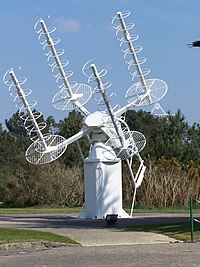Space operation service

Space operation service (short: SOS ; also: space operation radiocommunication service) is – according to Article 1.23 of the International Telecommunication Union's (ITU) Radio Regulations (RR)[1] – defined as A radiocommunication service concerned exclusively with the operation of spacecraft, in particular space tracking, space telemetry and space telecommand. These functions will normally be provided within the service in which the space station is operating.[2]
Frequency allocation[edit]
The allocation of radio frequencies is provided according to Article 5 of the ITU Radio Regulations (edition 2012).[3]
In order to improve harmonisation in spectrum utilisation, the majority of service-allocations stipulated in this document were incorporated in national Tables of Frequency Allocations and Utilisations which is with-in the responsibility of the appropriate national administration. The allocation might be primary, secondary, exclusive, and shared.
- primary allocation: is indicated by writing in capital letters (see example below)
- secondary allocation: is indicated by small letters
- exclusive or shared utilization: is within the responsibility of administrations
- Example of frequency allocation
| Allocation to services | ||
| Region 1 | Region 2 | Region 3 |
30.005–30.010 MHz
| ||
See also[edit]
References / sources[edit]
- ^ ITU Radio Regulations, Section IV. Radio Stations and Systems – Article 1.23, definition: space operation service / space operation radiocommunication service
- ^ "space operation service". National Telecommunications & Information Administration. Boulder, Colorado: Institute for Telecommunication Sciences.
- ^ ITU Radio Regulations, CHAPTER II – Frequencies, ARTICLE 5 Frequency allocations, Section IV – Table of Frequency Allocations
